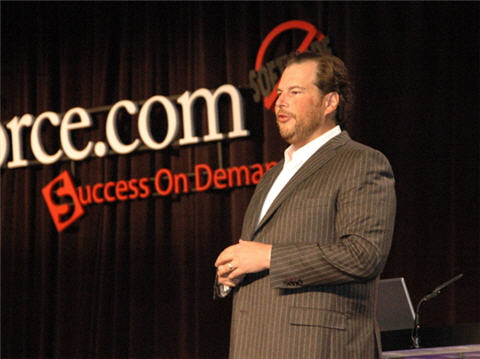Salesforce.com ascends to the cloud

Salesforce.com CEO Marc Benioff opened his "Tour de Force" presentation in San Francisco touting the prowess of the Force.com platform and his company--1 million subscribers, on track for more than $1 billion in its fiscal year (starting Feb. 1), 24 billion API calls to date, 130 million transactions daily, 210 millisecond average access speed, 160,000 SQL statements per second, 1.6 million lines of user code using the Apex language, 7 million automated tasks, 61,200 custom applications, 750 AppExchange applications and 38,000 AppExchange applications installed.
It's hard to argue with the current success of salesforce.com, its leadership in the SaaS space and cultivation of the platform-as-a-service concept. The best evidence of success is that salesforce has awakened Oracle, SAP and a host of startups who covet salesforce.com's market and strategy.
Benioff announced the latest news from salesforce, per-login pricing option for consuming less frequently accessed applications built on its Force.com platform and new development tools, which have been branded Development-as-a-Service (see this post).
Salesforce differentiates itself from competitors by offering a complete on demand service for developing and deploying applications, in addition to its CRM-oriented applications.
Benioff brought Marc Andreessen, Netscape, Loudcloud, Opsware and Ning founder, to the stage to talk about platforms-as-a-service. He gave a commercial the Ning social networking service with more than 150,000 sites, offering it as another example of platform-as-a-service that allows developers to extend an Internet platform.
"There will be a whole wave of new Internet platform companies," Andreessen said. "The good news it there is a common definition of 'platform'--you, the end user, can program it," Andreessen said. "In the past, for the last 40 or 50 years, you run [software] on single computer that you mostly have to buy, own, and manage. This shift to an Internet-based, hosted or cloud or whatever you want to call it, running on the Internet, is a very big deal. It opens up all kinds of possibilities. There will be literally thousands of new companies and we are just starting to see the cascading of that. We have seen a wave of Web services APIs and a second wave of plug-in APIs, like Facebook apps, and now the third wave like salesforce, Ning, Amazon's S3 and a growing number of startups where code is uploaded to run in cloud."
"The concepts are applicable to many different domains--enterprise, consumer, financial service, gaming, analytics, medical," he continued.
Andreessen also called out the live nature of the new generation of Internet-based applications. "The cloud platform is not just running code but also accessing data and Web services APIs, which can be live connections to services that do valuable things. By definition its a service or system that can be used simultaneously by thousands or millions of people. It's inherently social--people collaborating on building and using the applications. Live data and live services and live people, and the whole thing is connected. It's fertile ground for creativity."
He noted that the new platforms are build on piece parts from the old world. "We are building the Ning platform on old style platforms and providing a new style platform to our users and developers. They never have to deal with SQL, the hardware, operating systems or shell prompts...it's purely at the HTML and scripting level."
The big deal is that Internet, cloud platforms make is far easier to create and deploy applications. Even at the heart of Silicon Valley with world's most sophisticated technical people, startups are building their companies and products virtually. The cloud has arrived, and ironically it is creating more sunlight than shade. The big profits will come later...
